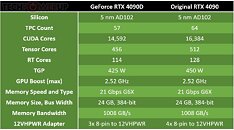- Joined
- Oct 9, 2007
- Messages
- 47,638 (7.44/day)
- Location
- Dublin, Ireland
| System Name | RBMK-1000 |
|---|---|
| Processor | AMD Ryzen 7 5700G |
| Motherboard | Gigabyte B550 AORUS Elite V2 |
| Cooling | DeepCool Gammax L240 V2 |
| Memory | 2x 16GB DDR4-3200 |
| Video Card(s) | Galax RTX 4070 Ti EX |
| Storage | Samsung 990 1TB |
| Display(s) | BenQ 1440p 60 Hz 27-inch |
| Case | Corsair Carbide 100R |
| Audio Device(s) | ASUS SupremeFX S1220A |
| Power Supply | Cooler Master MWE Gold 650W |
| Mouse | ASUS ROG Strix Impact |
| Keyboard | Gamdias Hermes E2 |
| Software | Windows 11 Pro |
NVIDIA today formally launched the China-specific GeForce RTX 4090D graphics card for gaming and creator applications, after it was banned this October by the United States Federal Trade Commission from exporting the RTX 4090 (among other AI GPUs) to China. The RTX 4090D comes with a reduced AI inference performance than the RTX 4090 to comply with the US-FTC limits, and measures are put in place to prevent end-users from modifying it into a regular RTX 4090. Besides firmware and driver-level performance limiters, the card gets a completely different ASIC code, a different device ID (which prevents BIOS transplants from the RTX 4090); and a different core-configuration of the 5 nm "AD102" silicon itself.
The "AD102" silicon physically has 72 TPCs (144 SM), from which NVIDIA carved out the original RTX 4090 by enabling 64 TPCs (128 SM). The new RTX 4090D only gets 57 TPCs (114 SM), which reduces the counts of the CUDA cores, Tensor cores, and RT cores. While the original RTX 4090 has 16,384 CUDA cores, 512 Tensor cores, and 128 RT cores; the new RTX 4090D is configured with 14,592 CUDA cores, 456 Tensor cores, and 114 RT cores. The GPU clocks are the same, both boost up to 2.52 GHz, although the power limits are reduced, with the TGP lowered by 25 W. The memory sub-system appears untouched. We are also hearing that overclocking of the RTX 4090D will be limited, with lower slider limits—all to prevent end-users from regaining AI inference performance levels comparable to an RTX 4090. NVIDIA is pricing the RTX 4090D at a baseline price of RMB ¥12,999 ($1,840), which was the launch price of the original RTX 4090 in China, before it was scalped out of existence there.

View at TechPowerUp Main Site
The "AD102" silicon physically has 72 TPCs (144 SM), from which NVIDIA carved out the original RTX 4090 by enabling 64 TPCs (128 SM). The new RTX 4090D only gets 57 TPCs (114 SM), which reduces the counts of the CUDA cores, Tensor cores, and RT cores. While the original RTX 4090 has 16,384 CUDA cores, 512 Tensor cores, and 128 RT cores; the new RTX 4090D is configured with 14,592 CUDA cores, 456 Tensor cores, and 114 RT cores. The GPU clocks are the same, both boost up to 2.52 GHz, although the power limits are reduced, with the TGP lowered by 25 W. The memory sub-system appears untouched. We are also hearing that overclocking of the RTX 4090D will be limited, with lower slider limits—all to prevent end-users from regaining AI inference performance levels comparable to an RTX 4090. NVIDIA is pricing the RTX 4090D at a baseline price of RMB ¥12,999 ($1,840), which was the launch price of the original RTX 4090 in China, before it was scalped out of existence there.

View at TechPowerUp Main Site






